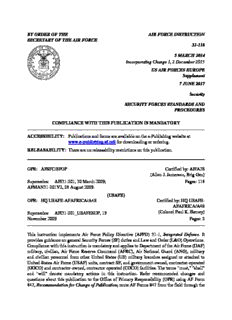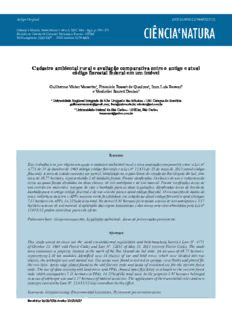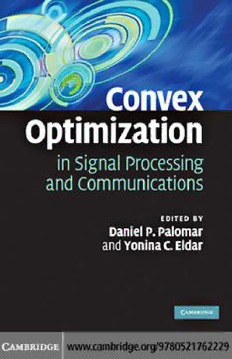
Convex optimization in signal processing and communications PDF
Preview Convex optimization in signal processing and communications
This page intentionally left blank ConvexOptimizationinSignalProcessingandCommunications Overthepasttwodecadestherehavebeensignificantadvancesinthefieldofoptimiza- tion. In particular, convex optimization has emerged as a powerful signal-processing tool, and the range of applications continues to grow rapidly. This book, written by a teamofleadingexperts,setsoutthetheoreticalunderpinningsofthesubjectandprovides tutorialsonawiderangeofconvex-optimizationapplications.Emphasisthroughoutis placedoncutting-edgeresearchandonformulatingproblemsinconvexform,making thisanidealtextbookforadvancedgraduatecoursesandausefulself-studyguide. Topicscovered: • automaticcodegeneration • graphicalmodels • gradient-basedalgorithmsforsignalrecovery • semidefiniteprogramming(SDP)relaxation • radarwaveformdesignviaSDP • blindsourceseparationforimageprocessing • modernsamplingtheory • robustbroadbandbeamforming • distributedmultiagentoptimizationfornetworkedsystems • cognitiveradiosystemsviagametheory • thevariational-inequalityapproachforNash-equilibriumsolutions DanielP.PalomarisanAssistantProfessorintheDepartmentofElectronicandComputer Engineering at the Hong Kong University of Science and Technology (HKUST). He receivedhisPh.D.fromtheTechnicalUniversityofCatalonia(UPC),Spain,in2003;was aFulbrightScholaratPrincetonUniversityduring2004–2006;andhassincereceived numerousawardsincludingthe2004YoungAuthorBestPaperAwardbytheIEEESignal ProcessingSociety. YoninaC.EldarisaProfessorintheDepartmentofElectricalEngineeringattheTechnion, IsraelInstituteofTechnology,andisalsoaResearchAffiliatewiththeResearchLabo- ratoryofElectronicsatMIT.ShereceivedherPh.D.fromtheMassachusettsInstituteof Technology(MIT)in2001.Shehasreceivedmanyawardsforherresearchandteach- ing,including,theWolfFoundationKrillPrizeforExcellenceinScientificResearch,the HershelRichInnovationAwardandtheMuriel&DavidJacknowAwardforExcellence inTeaching. Convex Optimization in Signal Processing and Communications Editedby DANIEL P. PALOMAR HongKongUniversityofScienceandTechnology and YONINAC.ELDAR Technion–IsraelInstituteofTechnology CAMBRIDGEUNIVERSITYPRESS Cambridge, New York, Melbourne, Madrid, Cape Town, Singapore, São Paulo, Delhi, Dubai, Tokyo Cambridge University Press The Edinburgh Building, Cambridge CB2 8RU, UK Published in the United States of America by Cambridge University Press, New York www.cambridge.org Information on this title: www.cambridge.org/9780521762229 © Cambridge University Press 2010 This publication is in copyright. Subject to statutory exception and to the provision of relevant collective licensing agreements, no reproduction of any part may take place without the written permission of Cambridge University Press. First published in print format 2009 ISBN-13 978-0-511-69123-2 eBook (NetLibrary) ISBN-13 978-0-521-76222-9 Hardback Cambridge University Press has no responsibility for the persistence or accuracy of urls for external or third-party internet websites referred to in this publication, and does not guarantee that any content on such websites is, or will remain, accurate or appropriate. Contents Listofcontributors page ix Preface xi 1 Automaticcodegenerationforreal-timeconvexoptimization 1 JacobMattingleyandStephenBoyd 1.1 Introduction 1 1.2 Solversandspecificationlanguages 6 1.3 Examples 12 1.4 Algorithmconsiderations 22 1.5 Codegeneration 26 1.6 CVXMOD:apreliminaryimplementation 28 1.7 Numericalexamples 29 1.8 Summary,conclusions,andimplications 33 Acknowledgments 35 References 35 2 Gradient-basedalgorithmswithapplicationstosignal-recovery problems 42 AmirBeckandMarcTeboulle 2.1 Introduction 42 2.2 Thegeneraloptimizationmodel 43 2.3 Buildinggradient-basedschemes 46 2.4 Convergenceresultsfortheproximal-gradientmethod 53 2.5 Afastproximal-gradientmethod 62 2.6 Algorithmsforl -basedregularizationproblems 67 1 2.7 TV-basedrestorationproblems 71 2.8 Thesource-localizationproblem 77 2.9 Bibliographicnotes 83 References 85 vi Contents 3 Graphicalmodelsofautoregressiveprocesses 89 JitkomutSongsiri,JoachimDahl,andLievenVandenberghe 3.1 Introduction 89 3.2 Autoregressiveprocesses 92 3.3 Autoregressivegraphicalmodels 98 3.4 Numericalexamples 104 3.5 Conclusion 113 Acknowledgments 114 References 114 4 SDPrelaxationofhomogeneousquadraticoptimization:approximation boundsandapplications 117 Zhi-QuanLuoandTsung-HuiChang 4.1 Introduction 117 4.2 NonconvexQCQPsandSDPrelaxation 118 4.3 SDPrelaxationforseparablehomogeneousQCQPs 123 4.4 SDPrelaxationformaximizationhomogeneousQCQPs 137 4.5 SDPrelaxationforfractionalQCQPs 143 4.6 MoreapplicationsofSDPrelaxation 156 4.7 Summaryanddiscussion 161 Acknowledgments 162 References 162 5 Probabilisticanalysisofsemidefiniterelaxationdetectorsformultiple-input, multiple-outputsystems 166 AnthonyMan-ChoSoandYinyuYe 5.1 Introduction 166 5.2 Problemformulation 169 5.3 AnalysisoftheSDRdetectorfortheMPSKconstellations 172 5.4 ExtensiontotheQAMconstellations 179 5.5 Concludingremarks 182 Acknowledgments 182 References 189 6 Semidefiniteprogramming,matrixdecomposition,andradarcodedesign 192 YongweiHuang,AntonioDeMaio,andShuzhongZhang 6.1 Introductionandnotation 192 6.2 Matrixrank-1decomposition 194 6.3 Semidefiniteprogramming 200 6.4 Quadraticallyconstrainedquadraticprogrammingand itsSDPrelaxation 201 Contents vii 6.5 PolynomiallysolvableQCQPproblems 203 6.6 Theradarcode-designproblem 208 6.7 Performancemeasuresforcodedesign 211 6.8 Optimalcodedesign 214 6.9 Performanceanalysis 218 6.10 Conclusions 223 References 226 7 Convexanalysisfornon-negativeblindsourceseparationwith applicationinimaging 229 Wing-KinMa,Tsung-HanChan,Chong-YungChi,andYueWang 7.1 Introduction 229 7.2 Problemstatement 231 7.3 Reviewofsomeconceptsinconvexanalysis 236 7.4 Non-negative,blindsource-separationcriterionviaCAMNS 238 7.5 Systematiclinear-programmingmethodforCAMNS 245 7.6 Alternatingvolume-maximizationheuristicsforCAMNS 248 7.7 Numericalresults 252 7.8 Summaryanddiscussion 257 Acknowledgments 263 References 263 8 Optimizationtechniquesinmodernsamplingtheory 266 TomerMichaeliandYoninaC.Eldar 8.1 Introduction 266 8.2 Notationandmathematicalpreliminaries 268 8.3 Samplingandreconstructionsetup 270 8.4 Optimizationmethods 278 8.5 Subspacepriors 280 8.6 Smoothnesspriors 290 8.7 Comparisonofthevariousscenarios 300 8.8 Samplingwithnoise 302 8.9 Conclusions 310 Acknowledgments 311 References 311 9 Robustbroadbandadaptivebeamformingusingconvexoptimization 315 MichaelRübsamen,AmrEl-Keyi,AlexB.Gershman,andThiaKirubarajan 9.1 Introduction 315 9.2 Background 317 9.3 Robustbroadbandbeamformers 321 9.4 Simulations 330 viii Contents 9.5 Conclusions 337 Acknowledgments 337 References 337 10 Cooperativedistributedmulti-agentoptimization 340 AngeliaNedic´andAsumanOzdaglar 10.1 Introductionandmotivation 340 10.2 Distributed-optimizationmethodsusingdualdecomposition 343 10.3 Distributed-optimizationmethodsusingconsensusalgorithms 358 10.4 Extensions 372 10.5 Futurework 378 10.6 Conclusions 380 10.7 Problems 381 References 384 11 CompetitiveoptimizationofcognitiveradioMIMOsystemsviagametheory 387 GesualsoScutari,DanielP.Palomar,andSergioBarbarossa 11.1 Introductionandmotivation 387 11.2 Strategicnon-cooperativegames:basicsolutionconceptsandalgorithms 393 11.3 Opportunisticcommunicationsoverunlicensedbands 400 11.4 Opportunisticcommunicationsunderindividual-interference constraints 415 11.5 Opportunisticcommunicationsunderglobal-interferenceconstraints 431 11.6 Conclusions 438 Acknowledgments 439 References 439 12 Nashequilibria:thevariationalapproach 443 FranciscoFacchineiandJong-ShiPang 12.1 Introduction 443 12.2 TheNash-equilibriumproblem 444 12.3 Existencetheory 455 12.4 Uniquenesstheory 466 12.5 Sensitivityanalysis 472 12.6 Iterativealgorithms 478 12.7 Acommunicationgame 483 Acknowledgments 490 References 491 Afterword 494 Index 495
The list of books you might like

Rich Dad Poor Dad

Corrupt (Devil's Night #1)

The Silent Patient

The Spanish Love Deception

FREE E-Book The Unseen Therapist

BY ORDER OF THE COMMANDER MAXWELL AFB INSTRUCTION 32-2003 42D AIR BASE WING ...

Cento Anni di Ricerca Petrolifera(1)

Live and let live

Structured glass-fiber catalysts

Vitis vinifera subsp. vinifera cv. Marselan
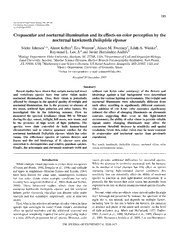
DTIC ADA519442: Crepuscular and Nocturnal Illumination and Its Effects on Color Perception by the Nocturnal Hawkmoth Deilephila elpenor
![Carillon, [Spring 2006] book image](https://cdn.pdfdrive.to/media/content/thumbnails/4a9d8608-f5cb-4569-86da-81adbdb75f38.webp)
Carillon, [Spring 2006]
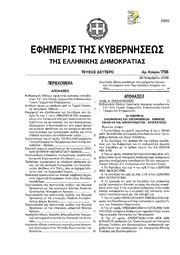
Greek Government Gazette: Part 2, 2006 no. 1706

The Natal Museum and its journals : celebrating a century of publication, 1906-2005
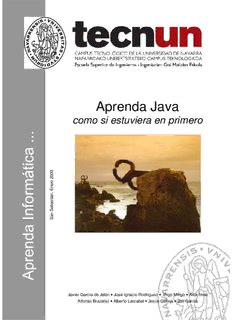
Aprenda Java - Tecnun :: Universidad de Navarra: tecnun
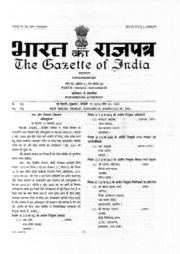
Union Government, Extraordinary, 2010-01-15, Part II-Section 3-Sub-Section(ii), Ref. S.O. 87(E)

Caldaia murale a gas ad alto rendimento
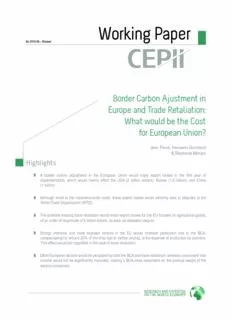
Border Carbon Ajustment in Europe and Trade Retaliation

Calibrated Spline Estimation of Detailed Fertility Schedules from Abridged Data
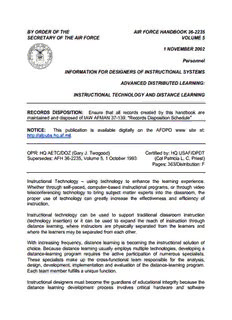
BY ORDER OF THE AIR FORCE HANDBOOK - The Air University
